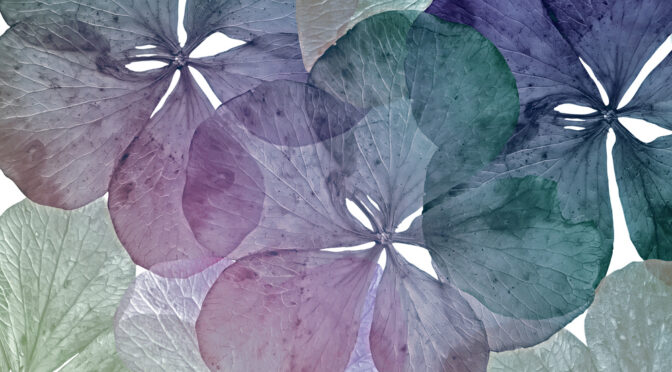The next time you want to show off a little flair in the kitchen, or impress your friends and family with a little extra beauty in your dessert, you may not have to look much further than your own garden at home.
Humans have always been foragers, so we’ve been eating flowers and using them for medicinal purposes for longer than we’ve been recording our history. Some have been used in herbal medicine and culinary classics that have been eaten for many thousands of years, dating all the way back to ancient Rome, Greece, China, India and the Middle East. Most ancient civilizations used flowers quite commonly in their traditional cooking. such as squash flowers in mediterranean food, and roses in Indian and Middle Eastern cuisine.
In this article we’re going to show you some examples of the most common edible flowers, the best ways to use them, and even how they can give your health a little boost. Keep in mind, edible flowers can be found all over the world. Some may be found just about everywhere, while some may be endemic (found nowhere else) to your local area.
A good example of this, are the Waterblommetjie Flowers (pronounced “Water-bloom-ekee”) that are only found in the Western Cape region of South African and are cooked in traditional South African stews. (I’ve tried them before and they taste absolutely incredible!) That’s why it’s always good to look around and do a little research. There are thousands of edible flowers in the world. You never know what rare delicacies you may find growing nearby!
Just a few important things to consider. First, make sure you don’t eat any plants you aren’t 100% sure of. Many plants can look similar, and may actually be poisonous. And also, it’s not a good idea to eat flowers from florists and nurseries, or in parks and other areas where they may have been sprayed with chemicals. It’s always safest to eat flowers you’ve grown yourself.
1 – Marigolds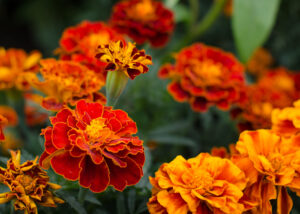
Marigolds are a great flower for eating in salads.
They are very versatile and can add a bit of spicy-tangy-peppery flavor to just about any dish, raw or cooked. The smell they give off is also a great pest deterrent.
Good to keep in mind for BBQ’s and picnics! Marigolds are also highly prized for their medicinal capabilities. They have antiseptic, anti-inflammatory and antibacterial properties.
2 – Carnation Petals
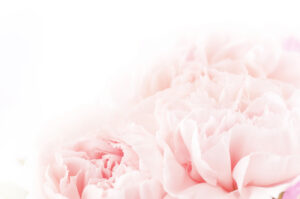 Yep, the same flower you see in those floral arrangements all the time. The petals taste sweet, once you trim them away from the bitterness of their base.
Yep, the same flower you see in those floral arrangements all the time. The petals taste sweet, once you trim them away from the bitterness of their base.
They have a sweet, delicate, perfumed taste, that is almost exactly how they smell. They are often used in candy, cake and wine.
In ancient China, carnation flower tea was widely used to help the body and spirit relax, and to restore energy in the body, as well as to combat depression and anxiety.
We still use it for those reasons, but today it’s used for just about everything in China, including hair loss and excess gas. Cool fact? Carnations are one of the secret ingredients in the french liqueur ‘Chartreuse’.
3 – Allium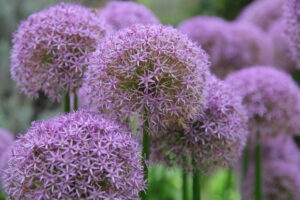
All blossoms from the allium family (chives, leaks, garlic, etc.) are edible and very flavorful! All parts of them are edible, and can have a broad range in flavors.
A wide array of sulfur compounds in the plants are what gives onions, garlic, and other alliums their infamous taste, smell, and tear-inducing abilities, as well as their many health benefits.
This includes cardiovascular protection, anti-cancer properties, the ability to lower cholesterol and blood pressure, as well as providing anti-clotting benefits. Great for people with health issues like heart disease.
4 – Borage Blossoms
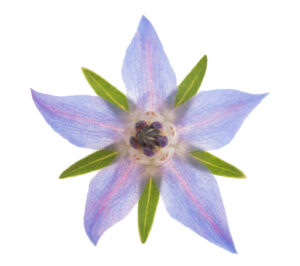 Borage blossoms (also known as Starflowers) are a beautiful blue color and they taste just like cucumbers.
Borage blossoms (also known as Starflowers) are a beautiful blue color and they taste just like cucumbers.
They make a wonderful addition to salads, (like potato salad) or delicate little finger sandwiches for parties.
When brewed into a tea, they have a very calming, natural sedative effect that can help you relax and sleep.
It’s also great for depression and mood swings, especially when they are brought on by hormonal changes.
5 – Chrysanthemums
They’re a little on the bitter side, but if you mix them in with flavorful dishes you won’t even notice. They’re also very common, and come in a wide range of colors. They’re handy to keep around in the garden if you want to add a little surprise flair to a dish. When it comes to health benefits, they are also great for brewing into a tea. They’ve been used in Chinese Medicine for several hundred years as a natural way to combat headaches, tinnitus and dizziness. The tea also has a natural cooling effect, so it’s commonly used around the world to treat fever and heat stroke.
6 – Clover
Those little white, pink or purple flowers you see growing amongst the wild clover? Yep. They’re edible! They taste sweet, but also have a hint of licorice flavor in the background. They are great when it comes to improving circulation in the body. Clover flowers also contain calcium, magnesium, niacin, phosphorus, potassium, thiamine, and vitamin C. They’re a really simple way to add a healthy boost to your salads.
7 – Dandelions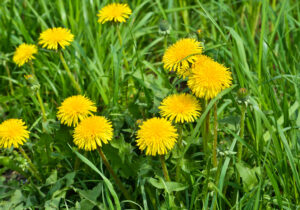
You should have lots of these little flowers growing around the neighborhood.
They’re often considered pest flowers but that couldn’t be furthest from the truth. First of all, these spring flowers are very important when it comes to the survival of your local bees.
Second, they are completely edible, raw or cooked. All the way from the root to the flower. The roots are used to make dandelion tea, a common substitute for coffee.
The leaves are bitter when eaten raw, but get sweeter if you cook them, such as in a stir fry. The flowers are sweet and a little crunchy even. They are often eaten raw in salads, but you can also bread them and fry them. There are countless articles on the web about their many health benefits, so I won’t even bother going into that here.
8 – Gladiolus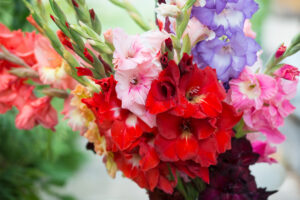
Gladioli flowers do taste a little bland and boring, but on the bright side that means the petals can be added to just about any dish without disrupting the flavor.
They can also be stuffed with various ingredients and baked in the oven. As for their health benefits, we know of several but more are discovered all the time.
We know they assist digestion and can delicately relieve constipation. We also know they can help ease muscle cramps, including cramps from menstruation. Recently, scientists may have even found a way to use Gladiolus to help people suffering from nervous system issues, but the verdict is still out on that one.
9 – Lavender
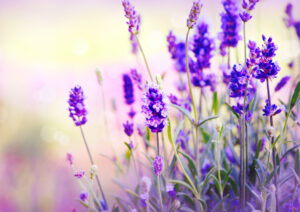 Lavender is a great flower to include in your cooking. It’s a little sweet and a little spicy. For that reason it can be used in both sweet and savory dishes.
Lavender is a great flower to include in your cooking. It’s a little sweet and a little spicy. For that reason it can be used in both sweet and savory dishes.
It also works great as an addition to a batch of lemonade, adding a hint of flavor and a bright, vibrant purple color. Many people claim Lavender has antiseptic and anti-inflammatory properties.
For this reason it is often used to heal bug bites and minor scrapes. Research has also proved that lavender essential oil can be useful for treating restlessness, anxiety, nervousness and depression. Although, they say it should not be used by pregnant women or lactating mothers.
10 – Squash, Pumpkin and Zucchini Flowers
Many different types of these are used in italian dishes. They can be roasted, sauteed, slow cooked into certain sauces, breaded and fried or even stuffed like cannelloni or jalapeno peppers. When used in such a way, they taste a lot like the veggies they would have become had they grown longer. They are also packed full of vitamins and minerals, including Vitamin C, Vitamin A, Folate, Potassium and Iron.
11 – Violets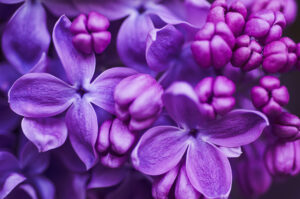
One of the world’s most popular edible flowers. They are very beautiful and sweet smelling.
They add a soft and delicate floral flavor to just about any dish. Most commonly they are used as a garnish for salads, desserts and drinks. They are even used as a breath freshener!
Violets have also been used as a medicine for thousands of years. They’ve been used to treat acne, asthma, bronchitis, cold and flu, eczema, headache, lymphatic congestion, mastitis, mumps, psoriasis, sore throat, ulcers, urinary tract infections, varicose veins, and even whooping cough.
Next time you have a headache and have a few violets laying around, try a violet compress! Just soak a cloth for a few minutes in some violet tea, then put the cloth on the back of your neck. It’s worked every time I’ve tried it!
12 – Roses
 Roses are very common in traditional meals found in countries all over the world.
Roses are very common in traditional meals found in countries all over the world.
Rose water is used for many different purposes. Just keep in mind that only the petals are edible because the base is far too bitter.
All roses are can be eaten, though the darker the color the stronger the flavor tends to be. When it comes to the health benefits of roses, they are numerous.
Rose oil is used as an antidepressant, an antiseptic, an aphrodisiac, an astringent, an antibacterial and anti-inflammatory drug. It can even be used as a delicate natural laxative.
13 – Sunflowers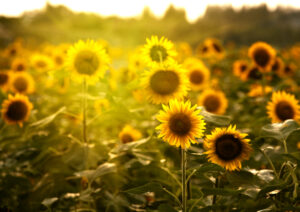
We all know you can eat the seeds, but did you know you can eat the stems, buds and petals too? The stems taste like collard greens.
The buds taste a lot like an artichoke, and can be cooked in almost all the same ways.
The flower petals can be used as a garnish, or as an addition to a fresh spring salad. Sunflowers are packed with vitamins and minerals, but they also have a few rather amazing medicinal properties..
Like the ability to drastically reduce cholesterol levels in the body, and to even rid your stomach of intestinal worms and parasites.
14 – Mint Flowers
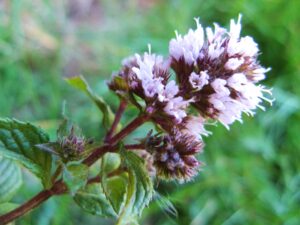 The flowers of the mint plant taste.. Minty! Big surprise there, eh? If you’re lucky, you may even be able to find a chocolate mint plant.
The flowers of the mint plant taste.. Minty! Big surprise there, eh? If you’re lucky, you may even be able to find a chocolate mint plant.
They are both excellent for adding some awesome flavor to teas, chocolate sauces, cookies, you name it.
As for it’s healing properties, it has plenty of those too. Mint is a great natural decongestant, fever reducer and headache reliever, making mint infused tea or water the perfect thing for when you’re sick.
Mint tea is also a powerful astringent, so it works wonders on acne too. That is, if you use it everyday.
15 – Chamomile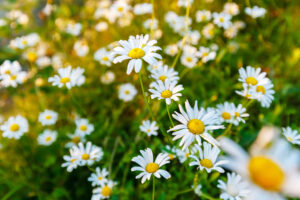
Chamomile plants have tiny little yellow flowers that almost look like daisies. The flowers taste sweet and are most commonly used in teas.
As you probably already know, Chamomile tea is perfect for helping us relieve stress and relax before bed.
Just remember though, it can be a very bad idea to serve chamomile to people who suffer from ragweed allergies. Always double check before serving, just to be sure.
16 – Citrus Blossoms
Just about all kinds of citrus blossoms are edible. Lemon, Orange, Kumquat, you name it. Just be very careful how much you include them in your dish, as they have a strong flavor that can quickly overpower it. That’s why they are most commonly used only as a garnish. The health benefits all depend on which flower you use. Orange blossoms tend to have different health benefits than apple or lemon blossoms.
17 – Jasmine Flowers
Jasmine flowers can be a beautiful addition to many dishes. Like Citrus blossoms they are sweet, but also super fragrant. For this reason they should also be used sparingly. According to research, Jasmine flowers are excellent for combating mood swings and other hormonal changes. It’s also occasionally used as a natural treatment for mild bipolar disorder. Supposedly, it also works as an aphrodisiac too.
18 – Hibiscus Flowers
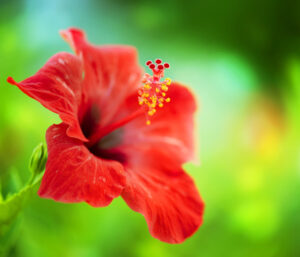 Hibiscus flowers are most commonly used to make tea, although they make a great addition to soups and sauces as well.
Hibiscus flowers are most commonly used to make tea, although they make a great addition to soups and sauces as well.
The taste is a little bitter, but a lot like a cranberry.
Hibiscus flowers are great for combating high blood pressure and inflammation, as well as abscesses and other types of blood infections.
Just remember though, as with Lavender, if you’re pregnant or breastfeeding then you shouldn’t consume it.
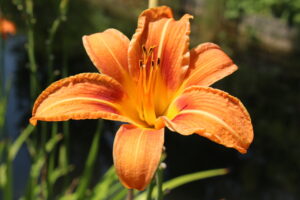 19 – Daylilies
19 – Daylilies
A very common and popular flower, daylilies are an excellent addition to a salad.
They taste a lot like lettuce so they can be added without disturbing any flavors.
They are also great for fighting cancer, they can detoxify arsenic in the body and they even act as a powerful antioxidant.
Just be careful not to eat too many of them, since they’ve been known to produce hallucinations when eaten in excess.
20 – Honeysuckle Flowers
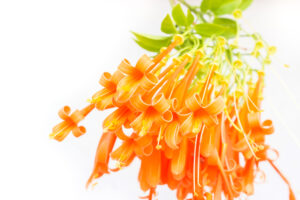 Honeysuckle has a sweet, honey like flavor. (Hence it’s name) Just remember, only the flowers are edible.
Honeysuckle has a sweet, honey like flavor. (Hence it’s name) Just remember, only the flowers are edible.
The berries are HIGHLY poisonous. The flowers are used in soups, salads, desserts and anywhere else a little sweet flavor is wanted with a little extra color.
As for it’s medical benefits, it’s used to treat infections, blood impurities, fever, flea and tick bites, gout, and even blocked fallopian tubes.
Written by Lara Starr

